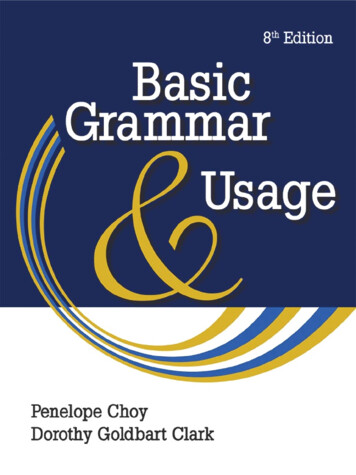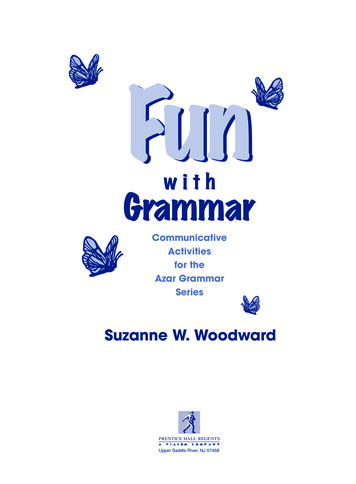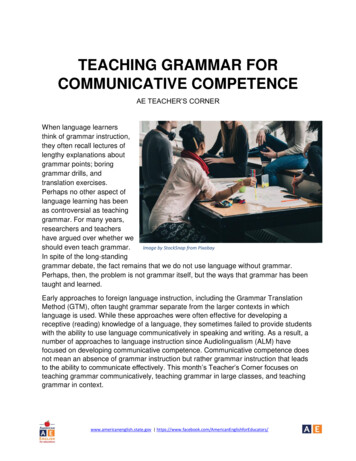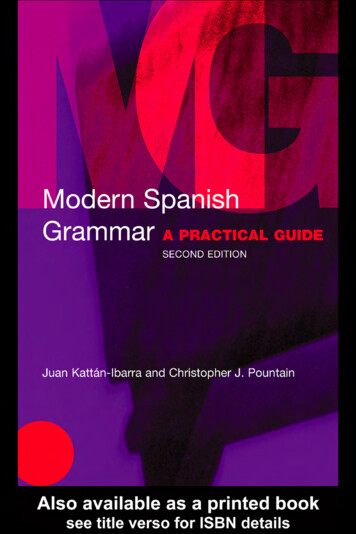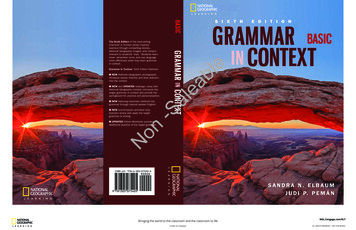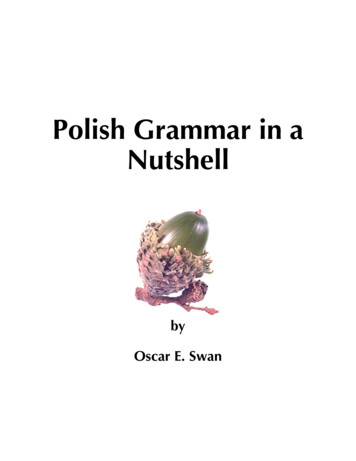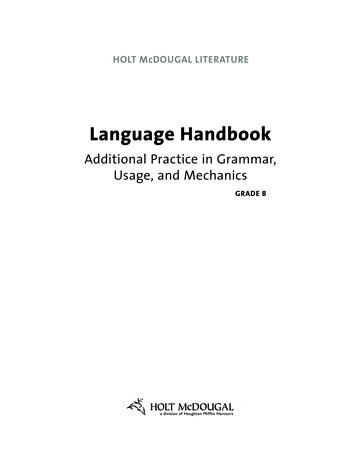
Transcription
HOLT McDOUGAL LITERATURELanguage HandbookAdditional Practice in Grammar,Usage, and MechanicsGRADE 800i TX L08LH.indd i6/3/09 11:12:06 PM
TX L08LH FM 6/1/09 6:12 PM Page iiCoverHand QJU/Shutterstock; white board Chris Cigliano/HoughtonMifflin Harcourt.Copyright by Houghton Mifflin Harcourt Publishing CompanyAll rights reserved. No part of this work may be reproduced ortransmitted in any form or by any means, electronic or mechanical,including photocopying or recording, or by any information storageor retrieval system, without the prior written permission of thecopyright owner unless such copying is expressly permitted byfederal copyright law.Permission is hereby granted to individuals using the correspondingstudent's textbook or kit as the major vehicle for regular classroominstruction to photocopy copying masters from this publication inclassroom quantities for instructional use and not for resale.Requests for information on other matters regarding duplication ofthis work should be addressed to Houghton Mifflin HarcourtPublishing Company, Attn: Contracts, Copyrights, and Licensing, 9400South Park Center Loop, Orlando, Florida 32819.Printed in the 1 2 3 4 5 6 7 8 9 10 0803 18 17 16 15 14 13 12 11 10 09If you have received these materials as examination copies free ofcharge, Houghton Mifflin Harcourt Publishing Company retains titleto the materials and they may not be resold. Resale of examinationcopies is strictly prohibited.Possession of this publication in print format does not entitleusers to convert this publication, or any portion of it, intoelectronic format.
TX L08LH FM 6/1/09 6:12 PM Page iiiTable of ContentsTo the Teacher . . . . . . . . . . . . . . . . . . . . . . . . . . . . . . . . . . . . . . . . . ixLanguage Handbook 1The Parts of tifying Nouns . . . . . . . . . . . . . . . . . . . . . . . . . 1Identifying and Using Pronouns . . . . . . . . . . . . . . 2Identifying Adjectives . . . . . . . . . . . . . . . . . . . . . . 3Identifying and Using Action and Helping Verbs . . 4Identifying Linking and Helping Verbs . . . . . . . . . 5Identifying and Using Adverbs . . . . . . . . . . . . . . . 6Identifying Prepositions and PrepositionalPhrases . . . . . . . . . . . . . . . . . . . . . . . . . . . . . . . . . 7Identifying Conjunctions and Interjections;Determining Parts of Speech . . . . . . . . . . . . . . . . 8Test . . . . . . . . . . . . . . . . . . . . . . . . . . . . . . . . . . . 9Language Handbook 2 Houghton Mifflin Harcourt Publishing sheet9Worksheet 10Worksheet 11Worksheet 12Worksheet 13Using Singular and Plural Forms . . . . . . . . . . . . . 12Making Subjects and Verbs Agree . . . . . . . . . . . . 13Using Subjects and Verbs with PrepositionalPhrases . . . . . . . . . . . . . . . . . . . . . . . . . . . . . . . . 14Ensuring Agreement with Indefinite Pronouns . . 15Ensuring Agreement with Subjects Joinedby And, Or, or Nor . . . . . . . . . . . . . . . . . . . . . . . 16Ensuring Agreement with Collective Nounsand with Don’t and Doesn’t . . . . . . . . . . . . . . . . 17Ensuring Agreement in Questions and inSentences That Begin with There and Here . . . . . 18Ensuring Agreement with Singular WordsThat Have Plural Forms . . . . . . . . . . . . . . . . . . . . 19Ensuring Agreement Between Pronoun andAntecedent . . . . . . . . . . . . . . . . . . . . . . . . . . . . . 20Avoiding Problems in Agreement of Pronounand Antecedent . . . . . . . . . . . . . . . . . . . . . . . . . 21Ensuring Pronoun-Antecedent Agreementwith And, Or, and Nor . . . . . . . . . . . . . . . . . . . . 22Avoiding Problems in Agreement of Pronounand Antecedent . . . . . . . . . . . . . . . . . . . . . . . . . 24Test . . . . . . . . . . . . . . . . . . . . . . . . . . . . . . . . . . 25Table of Contentsiii
TX L08LH FM6/1/096:12 PMPage ivLanguage Handbook 3Using VerbsWorksheet 1Worksheet 2Worksheet 3Worksheet 4Worksheet 5Worksheet 6Worksheet 7Worksheet 8Worksheet 9Worksheet 10Identifying Past, Present, and Future Tenses . . . . 28Using Irregular Verbs . . . . . . . . . . . . . . . . . . . . . 29More Practice with Irregular Verbs . . . . . . . . . . . 30Identifying and Using Verb Tenses . . . . . . . . . . . 32Using Consistent Verb Tense . . . . . . . . . . . . . . . . 34Identifying and Using Active and Passive Voice . . 37Using Sit and Set . . . . . . . . . . . . . . . . . . . . . . . . . 39Using Lie and Lay . . . . . . . . . . . . . . . . . . . . . . . . 40Using Rise and Raise . . . . . . . . . . . . . . . . . . . . . 41Test . . . . . . . . . . . . . . . . . . . . . . . . . . . . . . . . . . 42Language Handbook 4Using sheet3456WorksheetWorksheet78Identifying and Using Pronouns in theNominative Case . . . . . . . . . . . . . . . . . . . . . . . . . 46Identifying and Using Pronouns as PredicateNominatives . . . . . . . . . . . . . . . . . . . . . . . . . . . . 47Using Pronouns as Direct Objects . . . . . . . . . . . . 48Using Pronouns in the Objective Case . . . . . . . . 49Using Pronouns as Objects of Prepositions . . . . . 50Using Who and Whom and ReflexivePronouns . . . . . . . . . . . . . . . . . . . . . . . . . . . . . . 51More Practice with Pronouns . . . . . . . . . . . . . . . 52Test . . . . . . . . . . . . . . . . . . . . . . . . . . . . . . . . . . 53Language Handbook 5Using WorksheetWorksheet456Table of ContentsIdentifying and Using Modifiers in Regularand Irregular Comparisons. . . . . . . . . . . . . . . . . . 56Using Modifiers Correctly . . . . . . . . . . . . . . . . . . 57Using Other and Else; Avoiding DoubleComparisons and Double Negatives . . . . . . . . . . 58Correcting Misplaced Modifiers . . . . . . . . . . . . . 59Correcting Dangling and Misplaced Modifiers . . . 61Test . . . . . . . . . . . . . . . . . . . . . . . . . . . . . . . . . . 63 Houghton Mifflin Harcourt Publishing CompanyWorksheet
TX L08LH FM6/1/096:12 PMPage vLanguage Handbook rksheet5Worksheet6Worksheet7Worksheet8Identifying Prepositional Phrases . . . . . . . . . . . . 65Identifying and Using Adjective Phrases . . . . . . . 66Identifying and Using Adverb Phrases . . . . . . . . . 67Identifying Present and Past Participles andParticipial Phrases . . . . . . . . . . . . . . . . . . . . . . . . 68Identifying and Using Gerunds and GerundPhrases . . . . . . . . . . . . . . . . . . . . . . . . . . . . . . . . 70Identifying and Using Infinitives and InfinitivePhrases . . . . . . . . . . . . . . . . . . . . . . . . . . . . . . . . 71Identifying and Using Appositives andAppositive Phrases . . . . . . . . . . . . . . . . . . . . . . . 72Test . . . . . . . . . . . . . . . . . . . . . . . . . . . . . . . . . . 73Language Handbook heet2345Identifying Independent and SubordinateClauses . . . . . . . . . . . . . . . . . . . . . . . . . . . . . . . . 76Identifying and Using Adjective Clauses . . . . . . . 77Identifying and Using Adverb Clauses . . . . . . . . . 79Identifying Noun Clauses . . . . . . . . . . . . . . . . . . 81Test . . . . . . . . . . . . . . . . . . . . . . . . . . . . . . . . . . 82Language Handbook 8 Houghton Mifflin Harcourt Publishing sheet4Worksheet5Worksheet6Identifying Sentences and SentenceFragments . . . . . . . . . . . . . . . . . . . . . . . . . . . . . . 84Correcting Sentence Fragments . . . . . . . . . . . . . 85Identifying the Complete Subject and theComplete Predicate . . . . . . . . . . . . . . . . . . . . . . . 86Identifying the Simple Subject and theSimple Predicate . . . . . . . . . . . . . . . . . . . . . . . . . 87Identifying and Using Compound Subjectsand Compound Verbs . . . . . . . . . . . . . . . . . . . . . 88Test . . . . . . . . . . . . . . . . . . . . . . . . . . . . . . . . . . 89Table of Contentsv
TX L08LH FM6/1/096:12 PMPage viLanguage Handbook t4Worksheet5Identifying Subjects, Verbs, and Complements . . 92Identifying Direct Objects . . . . . . . . . . . . . . . . . . 93Identifying Direct Objects and IndirectObjects . . . . . . . . . . . . . . . . . . . . . . . . . . . . . . . . 94Identifying Linking Verbs, PredicateNominatives, and Predicate Adjectives . . . . . . . . 95Test . . . . . . . . . . . . . . . . . . . . . . . . . . . . . . . . . . 96Language Handbook 10Kinds of orksheet5Worksheet6Identifying Simple and Compound Sentences . . . 98Identifying Independent and SubordinateClauses . . . . . . . . . . . . . . . . . . . . . . . . . . . . . . . . 99Identifying Independent and SubordinateClauses . . . . . . . . . . . . . . . . . . . . . . . . . . . . . . . 100Indentifying Independent and SubordinateClauses . . . . . . . . . . . . . . . . . . . . . . . . . . . . . . . 101Classifying Sentences by Structure andPurpose . . . . . . . . . . . . . . . . . . . . . . . . . . . . . . 102Test . . . . . . . . . . . . . . . . . . . . . . . . . . . . . . . . . 104Language Handbook eet5Worksheet6WorksheetWorksheet78Table of ContentsCorrecting Run-on Sentences . . . . . . . . . . . . . . 107Correcting and Revising Run-on Sentences . . . . 108Combining Choppy Sentences by InsertingWords . . . . . . . . . . . . . . . . . . . . . . . . . . . . . . . . 110Combining Choppy Sentences by InsertingPhrases . . . . . . . . . . . . . . . . . . . . . . . . . . . . . . . 112Combining Choppy Sentences by Using And,But, or Or . . . . . . . . . . . . . . . . . . . . . . . . . . . . . 114Combining Choppy Sentences by UsingSubordinate Clauses . . . . . . . . . . . . . . . . . . . . . 117Revising Stringy and Wordy Sentences . . . . . . . 120Test . . . . . . . . . . . . . . . . . . . . . . . . . . . . . . . . . 123 Houghton Mifflin Harcourt Publishing CompanyWriting Effective Sentences
TX L08LH FM 6/1/09 6:12 PM Page viiLanguage Handbook 12Capital ksheet5WorksheetWorksheet67Using Capital Letters Correctly . . . . . . . . . . . . . 127Capitalizing Proper Nouns . . . . . . . . . . . . . . . . 128Capitalizing Proper Nouns . . . . . . . . . . . . . . . . 129Capitalizing Proper Adjectives and SchoolSubjects . . . . . . . . . . . . . . . . . . . . . . . . . . . . . . 131Capitalizing Proper Adjectives and SchoolSubjects . . . . . . . . . . . . . . . . . . . . . . . . . . . . . . 132Capitalizing Titles . . . . . . . . . . . . . . . . . . . . . . . 133Test . . . . . . . . . . . . . . . . . . . . . . . . . . . . . . . . . 134Language Handbook 13 Houghton Mifflin Harcourt Publishing ing End Marks . . . . . . . . . . . . . . . . . . . . . . . . 137Using End Marks and Periods AfterAbbreviations . . . . . . . . . . . . . . . . . . . . . . . . . . 138Using Commas to Separate Words andPhrases and After Introductory Elements . . . . . . 139Using Commas in Compound Sentencesand with Interrupters . . . . . . . . . . . . . . . . . . . . 140Using Commas with Interrupters and withIntroductory Words, Phrases, and Clauses . . . . . 141Using Commas for Dates and Addressesand in Letters . . . . . . . . . . . . . . . . . . . . . . . . . . 142Using Semicolons and Colons . . . . . . . . . . . . . . 144Test . . . . . . . . . . . . . . . . . . . . . . . . . . . . . . . . . 145Language Handbook orksheet12345Using Italics . . . . . . . . . . . . . . . . . . . . . . . . . . . 148Punctuating Quotations . . . . . . . . . . . . . . . . . . 149Punctuating Quotations and Dialogue . . . . . . . . 150Using Italics and Quotation Marks . . . . . . . . . . . 151Test . . . . . . . . . . . . . . . . . . . . . . . . . . . . . . . . . 152Table of Contentsvii
TX L08LH FM 6/1/09 6:12 PM Page viiiLanguage Handbook tWorksheet345Using Apostrophes to Show Possession . . . . . . 155Using Apostrophes for Contractions, Plurals,and Possessives . . . . . . . . . . . . . . . . . . . . . . . . . 156Using Hyphens . . . . . . . . . . . . . . . . . . . . . . . . . 158Using Parentheses and Dashes . . . . . . . . . . . . . 159Test . . . . . . . . . . . . . . . . . . . . . . . . . . . . . . . . . 160Language Handbook rksheet345Worksheet6Using Word Parts . . . . . . . . . . . . . . . . . . . . . . . 163Spelling Words with ie, ei, cede, ceed,and sede . . . . . . . . . . . . . . . . . . . . . . . . . . . . . . 164Adding Prefixes and Suffixes . . . . . . . . . . . . . . . 165Forming Plurals of Nouns . . . . . . . . . . . . . . . . . 166More Practice Forming the Plurals of Nounsand Spelling Numbers . . . . . . . . . . . . . . . . . . . . 167Test . . . . . . . . . . . . . . . . . . . . . . . . . . . . . . . . . 168Language Handbook 17Glossary of Usage123Common Usage Problems . . . . . . . . . . . . . . . . . 171Common Usage Problems . . . . . . . . . . . . . . . . . 172Test . . . . . . . . . . . . . . . . . . . . . . . . . . . . . . . . . 173 Houghton Mifflin Harcourt Publishing CompanyWorksheetWorksheetWorksheetviiiTable of Contents
TX L08LH FM6/4/091:39 AMPage ixTo the TeacherThis booklet, Language Handbook, contains practice and reinforcementcopying masters that cover the material presented in the GrammarHandbook section of the Student Edition. The worksheets reinforce thegrammar, usage, and mechanics rules and instruction covered in theGrammar Handbook. Tests at the end of each section can be used either forassessment or as end-of-section reviews. Houghton Mifflin Harcourt Publishing CompanyA separate Answer Key for the Language Handbook provides answers orsuggested responses to all items in this booklet.To the Teacherix
TX L08LH FM6/1/096:12 PMPage x
TX L08LH 016/1/096:09 PMPage 1NAMELanguageHandbookCLASSDATE1 The Parts of SpeechWORKSHEET 1Identifying NounsExercise A Draw a line under each noun in the following paragraph. Do notunderline pronouns. You will find twenty-five nouns.EXAMPLE[1] Perhaps the most surprising thing about the inventorThomas Edison is that he never seemed to need anysleep.[1] Most people need eight to ten hours of sleep nightly. [2] Edison, however, wasable to sleep much less and still work efficiently. [3] As a young man he began theschedule he continued for his entire life. [4] At night he earned his living. [5] During theday he read and studied. [6] He filled huge notebooks with notes on the books he readand the experiments he made. [7] Four hours of sleep was all he needed. [8] He had greatpowers of concentration. [9] When he was working on a project, he might go for dayswith hardly any rest. [10] His definition of genius was “one percent inspiration and ninetynine percent perspiration.”Exercise B Underline each noun in the following sentences. Capitalize any propernoun that you find by drawing a line through the first lowercase letter and writing thecapital letter above it.EXAMPLEAO1. This river flows into the atlantic ocean.1. Chinua achebe is a writer from nigeria. Houghton Mifflin Harcourt Publishing Company2. The nobel peace prize went to mother teresa for that year.3. On tuesday margaret left for a new job in japan.4. The team won a gold medal in hockey at the olympics.5. The dark-haired girl is a student visiting from colombia.6. To play baseball, ellen needs a mitt and some spiked shoes.7. Some new earrings are what debbie wants for her birthday.8. Armand wants to be a chef like his brother-in-law.9. Four of the largest ethnic groups in nigeria are the ibo, hausa, fulani, and yoruba.10. Our family visited the empire state building in new york city.The Parts of Speech1
TX L08LH 016/2/099:47 AMPage 2NAMELanguageHandbookCLASS1 The Parts of SpeechIdentifying and Using PronounsWORKSHEET 2Exercise ADATEUnderline each pronoun in the following sentences.EXAMPLE1. There are numerous breeds of dogs, and the AmericanKennel Club lists many of them.1. My friend Connie is proud of her cocker spaniel, which she herself found at an animalshelter.2. Usually cocker spaniels grow to about thirteen inches tall, but this is actually asomewhat smaller dog.3. Which would adapt itself better to city living, a small dog or a big one?4. Estrella has a malamute that everyone admires.5. Who gave it to her?Exercise B Write a pronoun or a pair of pronouns on each of the lines in thefollowing paragraph. You may use the same pronoun more than once.EXAMPLE[1] Not everyone knows that the Dracula legend is partlybased on fact.[1] think that the legend of Dracula is fiction. Actually [2] isbased on several old tales that tell of a fifteenth-century Romanian warrior [3]was known for [4] ruthlessness. [5] was called “Vlad the Impaler,”because some people say that [6] impaled [7] enemies on stakes.[8] was also known as Dracula, or “Son of the Dragon,” because [9][11] else was as ruthless with [12] prisoners as Vlad was.[13] say that often Vlad kept [14] locked up in [15]castle. [16] had they done to deserve such a fate? Of course, tellers of legendsoften exaggerate a person’s deeds. [17] make the person appear better orworse than [18] really was. [19] enjoy frightening [20]with tales of terror. Several years ago, a tomb that might have belonged to Vlad[21] was discovered by archaeologists. When [22] openedthe coffin that they suspected was [23] , the archaeologists found that[24] was empty. Could he have changed [25] into a bat like thelegendary Dracula and flown away?2Language Handbook Houghton Mifflin Harcourt Publishing Companyfather was called Vlad Dracul, or “Vlad the Dragon.” [10] say that
TX L08LH 016/1/096:09 PMPage 3NAMELanguageHandbookCLASSDATE1 The Parts of SpeechWORKSHEET 3Identifying AdjectivesExercise A Underline each of the adjectives in the following sentences. Do notinclude adjectives in book and story titles. Do not include the articles a, an, and the.EXAMPLE1. Washington Irving was one of the first American writerswho won an international reputation.1. Even as a young man, he had a whimsical spirit.2. In his humorous book The Sketch Book, he says he “made many tours of discoveryinto foreign parts and unknown regions” of his native city.3. A History of New York, his first book, was popular and successful.4. His quaint tales of life in the rural valleys near the Hudson River are delightful even today.5. Most students have heard of “Rip Van Winkle” and “The Legend of Sleepy Hollow.”6. These stories contain supernatural events.7. Irving spent many pleasant years in England and Spain.8. In Spain he wrote about Moorish legends.9. When he returned to this country, he built a comfortable house that he called“Sunnyside,” near Tarrytown, New York.10. He spent the rest of his long life there, devoting himself to literary matters.Exercise B In the following paragraph, underline each adjective and draw an arrowto the word it modifies. Do not include the articles a, an, and the. Houghton Mifflin Harcourt Publishing CompanyEXAMPLE[1] Our writing teacher gave our class a special assignment.[1] We are supposed to research haiku, which is a unique form of Japanese poetry.[2] A haiku is a short poem that expresses strong emotion or a vivid image in a few words.[3] After we have read English translations of several Japanese poems, our teacher wantsus to pick our favorite poet and write a brief report. [4] Our reports must be accurate, andwe will have to spend two hours in the library. [5] We don’t mind, because all of us thinkthe library is a great place for studying. [6] I am eager to start working on my subject, thefamous poet Taniguchi Buson. [7] I think his poetry is wonderful. [8] The librarian cangive me excellent tips on which poetry books I should research. [9] My teacher says herfavorite Japanese poet is Kobayashi Issa. [10] My best friend Felicia agrees that these poetsare masters.The Parts of Speech3
TX L08LH 016/2/099:47 AMPage 4NAMELanguageHandbookCLASSDATE1 The Parts of SpeechIdentifying and Using Action and Helping VerbsWORKSHEET 4Exercise A Underline the verbs in each of the following sentences. Be sure toinclude helping verbs.EXAMPLE1. Our football team might well win nearly every game thisseason.1. The crowd arrives early for Latisha’s rendition of the national anthem.2. Last week we played Burdick School.3. Their halfback towers above the other players.4. Our fullback ran the ball every time.5. During one play he dodged around left end.6. Our team did not block effectively, however.7. Our girls’ soccer team will defend its title as the state’s best.8. Sarah Chang has scored twenty-three goals in two seasons.9. She and Lena often practice together.10. Many of Lena’s friends have suggested Carrie as a new member of their team.On the line provided, supply a verb that will complete each sentence.In some sentences you will need to include a helping verb.Exercise BEXAMPLE1. For many years the riverhas floodedevery spring.1. Last month our family Hanukkah, a Jewish religious festival.3. Rita for Middletown at eight o’clock.4. She her destination by eleven-thirty tomorrow.5. The fog us many times on our way to school.6. I weather like this.7. Marc his teacher whether he could read a story by IsaacBashevis Singer.8. I for a summer job in the spring.9. I this assignment soon.10. From now on, I more care with these small jobs.4Language Handbook Houghton Mifflin Harcourt Publishing Company2. Hanukkah eight days each year.
TX L08LH 016/1/096:09 PMPage 5NAMELanguageHandbookCLASSDATE1 The Parts of SpeechWORKSHEET 5Identifying Linking and Helping VerbsExercise A Underline the linking verbs in the following sentences. Be sure tounderline any helping verbs as well.EXAMPLE1. Jimmy Carter, the thirty-ninth president of the UnitedStates, is from Georgia.1. Atlanta is the capital of Georgia.2. It has become an important center for trade and manufacturing.3. The state’s forests are a major source of wealth.4. Lumbering has been an important industry since the early days.5. Cotton remains one of the most valuable farm products in Georgia.6. Macon is considered a beautiful old city.7. This city is the birthplace of Sidney Lanier.8. Lanier became a well-known poet.9. Carson McCullers was another native of Georgia.10. The Heart Is a Lonely Hunter is one of her most popular novels.In the following sentences, underline each linking verb once. Underlineeach helping verb twice. Some linking verbs have helping verbs.Exercise BEXAMPLE1. Gardening remains an important part of many cultures.1. Bonsai, which means “planted in a tray” in Japanese, is the art of growing miniaturetrees in shallow pots. Houghton Mifflin Harcourt Publishing Company2. Bonsai is also the name of a tree that is grown in this manner.3. A tree will look ancient if the gardener controls its growth.4. If you prune the tree’s roots and branches often, it becomes stunted.5. The branches are made crooked by tying them with wire.6. Eventually, the tree will appear twisted and windblown.7. If you like a tree that smells nice, a pine tree or a cherry tree is a good choice.8. Your choice of container is important, too.9. It should be shallow earthenware and can be either plain or glazed.10. Matsuo Basho’s haiku about bonsai, “On a Withered Branch,” has become well known.The Parts of Speech5
TX L08LH 016/2/099:47 AMPage 6NAMELanguageHandbookCLASSDATE1 The Parts of SpeechIdentifying and Using AdverbsWORKSHEET 6Exercise A Underline the adverbs in each of the following sentences. Draw twolines under the word each adverb modifies.EXAMPLE1. We went back to our books.1. The temperature of the water at the fish hatchery seldom varies.2. The water never freezes.3. It comes from unusually large springs.4. It is very clear water.5. Vapor sometimes rises from warm water.6. Yesterday I read an article on the literature of India.7. Ancient Indian writers first produced hymns called Vedas in about 1500 B.C.8. Indian literature then entered its classical period.9. Writers of this period commonly wrote Sanskrit.10. Writers still use the classical version of Sanskrit.Exercise B Write a suitable adverb on the line provided within each sentence, andunderline the word it modifies. On the line provided at the beginning of the sentence,write the question the adverb answers: how? when? where? or to what extent?EXAMPLEhowcarefully1. Nikki and Emiliotheir puppet show.made plans for1. They had wanted to give a puppet show.3. Both painted faces on the puppets.4. Nikki and Emilio based their show on a Latin American folktale about La Llorona.5. had they heard of a figure so tragic as the weeping woman.6. the day of the show arrived.7. They arranged their theater on the lawn.8. The show went .9. The audience applauded .10. The two performers decided that they would create an even bettershow .6Language Handbook Houghton Mifflin Harcourt Publishing Company2. The two built a puppet theater and made papier-mâché puppets.
TX L08LH 016/1/096:09 PMPage 7NAMELanguageHandbookCLASSDATE1 The Parts of SpeechWORKSHEET 7Identifying Prepositions and Prepositional PhrasesExercise A Underline each prepositional phrase in the following sentences. Somesentences contain more than one prepositional phrase.EXAMPLE1. The discovery of fire was an important event in thehistory of civilization.1. Humans’ original source of fire was probably lightning.2. A fire started when a tree was struck by lightning.3. Early people probably took coals from this fire and preserved them in a shelter.4. The shelter was often deep within a cave.5. An attendant may have stayed beside the coals.6. All fires that the tribe needed probably were started by these coals.7. If the tribe moved, the keeper of the fire may have carried the coals.8. Sometimes a small fire was kept burning continuously in the shelter.9. The attendant probably stayed near the fire and kept it going.10. Humans first learned how to make their own fire during the Stone Age.In the following paragraph, underline each preposition and draw twolines under each object of a preposition.Exercise BEXAMPLE[1] Mahatma Gandhi worked to free his country from Britain.[1] India had been under British rule for many years. [2] Mahatma Gandhi, who was Houghton Mifflin Harcourt Publishing Companytrained as a lawyer, was an Indian reformer and nationalist. [3] Gandhi felt that Indiawould gain freedom only through nonviolent means, so he urged Indians struggling fortheir independence to boycott British institutions. [4] Because of his religious beliefs,Gandhi believed that the only way an opponent could be conquered was withnonviolence. [5] He believed that violence would bring with it only further violence. [6]His technique of nonviolence was called satyagraha, which literally means “grasping fortruth.” [7] According to Gandhi, anger weakens, but nonviolence is the weapon of thestrong. [8] He thought that a country could be administered on a nonviolent basis if themajority of the people were nonviolent. [9] One of the great disappointments of Gandhi’slife was that he was not able to make peace between the Hindus and Muslims of hiscountry. [10] He did, however, help India to achieve independence from Great Britain.The Parts of Speech7
TX L08LH 016/2/099:47 AMPage 8NAMELanguageHandbookCLASSDATE1 The Parts of SpeechIdentifying Conjunctions and Interjections;Determining Parts of SpeechWORKSHEET 8Exercise A In the following sentences, underline each conjunction once and eachinterjection twice. Not every sentence has an interjection.EXAMPLE1. Wow! The snow and wind are ferocious.1. Whew! This is certainly a cold and miserable day.2. It may be cold here, but in Alaska it is even colder.3. Neither sub-zero temperatures nor deep snow keeps the racers in the Iditarod frompacking their sleds and setting out, however.4. Both the dogs and their drivers often perform well in the cold.5. Do you want to participate in the race, or do you only want to watch?6. Hey, we should hurry to find a place at the starting line, for the race is about to begin.7. The key to winning the Iditarod is not only speed, but also endurance.8. I enjoy watching the race, yet I don’t like standing in the cold.9. Libby Riddles was exhausted but excited when she became the first woman to winthe Iditarod.10. Gosh, I’m glad I don’t have to qualify for and compete in that race!EXAMPLESN1. Tara Lipinski’s dream was to be an ice skater.V2. Do you dream of being a famous athlete?1. Chief Joseph pleaded the case of the Nez Perce well.2. Well, he was a great leader.3. We explored the river road.4. The river is almost overflowing its banks.5. Isabel towers over the other lacrosse players.6. Bright flags flew atop the towers of the castle.7. We waited a long time for Miles.8. We didn’t complain, for we knew he was busy.9. Greeting us warmly, Ron said, “Please have some refreshments.”10. Some don’t care for tuna.8Language Handbook Houghton Mifflin Harcourt Publishing CompanyExercise B On the line provided, identify the part of speech of each italicizedword. Write N for noun, PRON for pron
Handbook section of the Student Edition. The worksheets reinforce the grammar, usage, and mechanics rules and instruction covered in the Grammar Handbook. Tests at the end of each section can be used either for assessment or as end-of-section reviews. A separat


